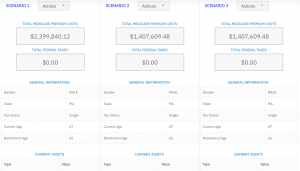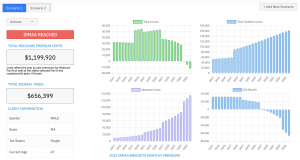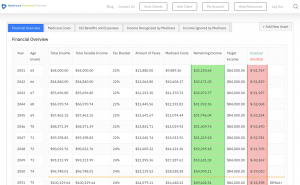Have you ever found yourself at a dinner party, the topic of healthcare costs comes up, and suddenly everyone’s an expert? Well, here’s something that might stump even the most well-read of your friends: what is the Medicare surcharge? It sounds like one of those things only accountants and lawyers know about. Yet, this matter touches a wider audience than one might initially assume.
In 2024, if you’re enrolled in Medicare Part B or D and earning over $103,000 a year alone or $206,000 with your spouse, congratulations – you’ve hit a financial milestone! And with it comes the IRMAA surcharge on top of your premiums. Yes, higher earnings means paying more for health coverage under Medicare. This isn’t just any extra fee; since 2007 for Part B and 2011 for Part D enrollees with high incomes have been navigating these waters.
Why does this matter to someone like me—or maybe someone like you? Because understanding these charges could mean saving money or at least not getting caught off guard by unexpected fees. So, it’s really about staying informed and making smart choices with your finances.
Understanding Medicare Surcharges and Additional Tax
What Is the Medicare Surcharge?
Ever opened a bill to find an unexpected charge? That’s how many feel when they see the Medicare surcharge, also known as IRMAA (Income-Related Monthly Adjustment Amount). But it’s not quite out of left field. If your wages sail over certain thresholds – $103,000 for individuals or more – buckle up. You’re in for this extra ride on top of your Medicare Part B and D premiums.
How IRMAA Affects Your Medicare Costs
This isn’t just any charge; think of it as the VIP pass nobody asked for. Based on earnings from two years back, if you’re living that high-income life, expect to pay more for your Medicare coverage. The goal? To have those with broader shoulders carry a bit more weight.
The Basics of Additional Medicare Tax
Apart from IRMAA making waves in your financial plans, there’s another guest at the party: additional medicare tax. Since 2013 – thanks to our friend ACA (Affordable Care Act) – high earners get hit with an extra 0.9% tax on wages and self-employment earnings past certain limits.
- Filing Single: Over $200K? Time to pay up.
- Coupled Up & Filing Jointly: Crossed $250K together? Welcome to club additional medicare tax.
- Making It Complicated: (Married but filing separately) Sitting pretty above $125K alone makes you eligible too.
Weirdly enough, while these might seem like pesky penalties, they ensure that Medicare can keep serving millions without blinking an eye. Read on about this essential piece of healthcare funding puzzle, including rates rules and everything else under the sun concerning these charges.
Calculating Your Medicare Costs and Surcharges
Determining Your Income Bracket for IRMAA
Let’s face it, figuring out Medicare costs can feel like you’re trying to solve a Rubik’s Cube. Blindfolded. But don’t worry, we’ve got your back.
The first step? Understand that little thing called the IRMAA surcharge. Yep, that stands for Income-Related Monthly Adjustment Amounts. Sounds fancy, but it basically means if you’re earning more dough than average Joe or Jane, expect to pay extra on top of your regular Medicare Part B and D premiums.
“But how much more?”, I hear you ask.
Adjusted Gross Income and Its Impact on Medicare Costs
Your Adjusted Gross Income (AGI) is the star of this show—it dictates which income bracket you fall into for those pesky IRMAA charges. Remember: This isn’t just about what lands in your bank account every month; it includes all sorts—wages, investments, even some retirement funds.
- If 2024 saw you pocketing over $194k as a dynamic duo filing jointly—or flying solo with $97k—you’ll be saying hello to additional payments in 2024.
- This calculation uses your MAGI from two years prior because Uncle Sam likes keeping things interesting by looking backwards to predict the future of your healthcare costs.
We know what’s going through your mind: “Can I dodge these charges?” The short answer? Maybe—if planning ahead is your jam. Reducing taxable earnings today might save some pennies tomorrow when facing down the barrel of an IRMAA charge gun. Planning strategies, such as harvesting investment losses or timing large financial events wisely could keep those extra dollars firmly in YOUR wallet rather than funding someone else’s medical adventures.
To sum up: Figuring out where you stand with Medicare taxes doesn’t have to be a nightmare wrapped inside a migraine headache served on a bed of forms. Know thy AGI. And remember—the goal here isn’t necessarily dodging taxes (we’re law-abiding citizens after all), but understanding them well enough so they don’t end up dodging YOU.
Key Takeaway:
Crack the Medicare code by understanding your AGI and its role in IRMAA surcharges. Planning ahead can keep extra charges at bay, letting you hold onto more of your hard-earned cash.
Strategies to Minimize Medicare Surcharges
Planning for Lower IRMAA Charges
We’ve all been there, staring at the Medicare statement and wondering, “How did it get so high?” It’s like ordering an appetizer and being billed for a five-course meal. But here’s the thing: You can trim that bill down. Yes, really.
First off, let’s talk about those pesky IRMAA charges. They sneak up on you based on your income but don’t fret; planning is your best friend here. The goal? Keeping your modified adjusted gross income (MAGI) in check.
- Dive into savings: Tucking money away into tax-deferred accounts can lower your MAGI today and reduce future IRMAA charges.
- Harness losses: If the market hands you lemons (a.k.a., investment losses), use them. Offsetting gains with losses can also keep your MAGI from ballooning.
- Roth conversions with care: Converting traditional IRA funds to Roth accounts makes sense sometimes but watch out – this increases your taxable earnings now, potentially bumping up those IRMAA costs temporarily.
Mastering the art of when to make your financial moves is crucial, as it directly influences your Modified Adjusted Gross Income’s ebb and flow. Like chess but less intimidating because you’re calling the shots.
Utilizing Estimated Tax Payments Effectively
Avoid paying medicare surcharges sounds pretty sweet, right? Here’s another gem: estimated payments. These aren’t just arbitrary numbers thrown onto paper every quarter; they’re potential lifesavers when it comes to managing taxes—and by extension—Medicare surcharges.
- Tax Withholding Adjustments: If working or receiving retirement benefits still counts among your daily activities, adjusting withholding on these earnings could help avoid nasty surprises come April 15th.
- Scheduled Quarterly Payments: No more “oops” moments with taxes due dates. Quarterly estimated tax payments tame that beast by spreading out what’s owed across four easier-to-swallow installments.
Key Takeaway:
Slash your Medicare surcharges by keeping an eye on your income. Dive into savings, smartly handle losses, and think before converting to Roth. Plus, don’t forget those tax payments. Every move counts in the game of lowering IRMAA charges.
Understanding Employer Obligations for Additional Medicare Tax Withholding
Alright, let’s talk about something that might sound a bit dry but is super important: withholding additional Medicare tax. This is the kind of stuff employers really need to get right unless they fancy a chat with the IRS – and trust me, no one wants that.
It’s all quite clear-cut, actually. Once an employee’s earnings zoom past $200,000 in a calendar year, it’s showtime for the extra 0.9% withholding action on those wages. And here’s where it gets interesting – this isn’t just any old tax; we’re talking about supporting our seniors through Medicare Part A, which covers hospital stays and more.
But hold up. Employers don’t just sit back after hitting that withhold button. Nope. They’ve got to report these withholdings quarterly using their federal tax filings – shout out to our friend, the employer’s quarterly federal tax.
- If you’re under-withholding? Better catch up before year-end or face potential penalties.
- Overshot your calculations? Time to give some cash back to your employees (and do so without delay).
No free passes here: even if there was an “oops” moment with withholding too little or too much, Uncle Sam expects employers to make things right—stat.
The twist? Your filing status doesn’t matter when it comes time for withholding this extra dough—it kicks off as soon as wages hit over $200k regardless of whether you’re single or married filing jointly.
A key takeaway? When dealing with anything IRS-related like withholding additional Medicare tax, precision is king (or queen). The goal is keeping both your employees happy and staying on good terms with those government folks who love their paperwork correct and punctual.
To sum up: Be sharp about tracking income levels within your team because once someone hits that magic number ($200K), it’s game-on for some extra payroll duties concerning Medicare taxes—and yes, making sure all ducks are neatly aligned come reporting time will save everyone from headaches down the road.
Key Takeaway:
Getting Medicare tax withholding right is a must for employers to avoid IRS trouble. Once an employee earns over $200K, it’s time to withhold an extra 0.9%, report quarterly, and correct any mistakes fast. Precision keeps everyone happy and compliant.
Reporting and Paying Additional Medicare Tax
Filing Requirements for Individuals and Employers, Handling Self-Employment Income and Taxes
Ah, the thrill of tax season. Just when you thought your dues were clear, here comes the additional Medicare tax knocking on your door if you’re one of the high earners or self-employed geniuses navigating through the labyrinth of IRS rules. Let’s demystify this together.
Who Owes Additional Medicare Tax?
If you’ve been blessed with a bumper year financially (think earnings over $200K as an individual or $250K for married folks filing jointly), congrats. But also, heads up—you might owe additional Medicare tax. This isn’t just about bragging rights; it’s about contributing that extra 0.9% to help fund our nation’s healthcare system.
Solo Flyers: Handling Self-Employment Income
- If solo flying is more your style (read: self-employment), get ready to pay both halves of this joyous occasion—the standard 2.9% plus an additional 0.9%, making it a grand total of 3.8% on wages above those same thresholds.
- No employer to withhold taxes? No problem. You’re steering this ship—estimated payments are your best friend here.
- The silver lining? It can make quite the difference come April if managed smartly throughout the year.
Employers’ Dance With Withholding
- For employers out there cringing at yet another task added to their plate—fear not. The magic number is $200K in employee earnings before that withholding curtain rises for the additional show called ‘Medicare Tax.’
- This performance doesn’t require matching steps from employers; simply ensure accurate withholding based on employees’ wages crossing that threshold.
- Overshot or undershot those withholdings? Make sure adjustments are done by end-year festivities—or face being liable for any missed steps in this dance sequence with Uncle Sam.
Tax Filing Tango: When tax time twirls around, reporting these figures becomes part of your annual financial recital.
Form W-4 plays center stage for employees adjusting their withholdings—a move worth considering if hitting those higher earning notes became a theme song last year. If all things taxes sound like cryptic code, getting familiar with this form can make a huge difference. It lets you fine-tune how much tax is taken out of your paycheck, ensuring that you’re not caught off guard when the season rolls around. So, it’s wise to give it a look and adjust as needed to match your current financial situation.
Key Takeaway:
Making more means paying more into Medicare, but with smart planning and timely payments, it doesn’t have to be a headache. Self-employed? You’ve got this with estimated payments. Employers, keep an eye on those earnings and withhold correctly to avoid year-end surprises.
Navigating Changes in Income and Its Effects on Medicare Costs
Adjusting to Decreased Income Levels
So, your earnings have taken a dive. It happens, right? Yet, the real twist is that this decline might jostle your Medicare premiums in ways you hadn’t anticipated. Less cash flowing in doesn’t just mean tightening the belt on daily expenses—it also means it might be time to give those Medicare costs a good hard look.
Luckily, there’s some flexibility built into the system for times like these. If you’ve hit a rough patch or are riding out an economic storm, knowing how to navigate these waters can keep you from overpaying when money is tight.
Life Changing Events That Affect Your Premiums
Gone through something big lately? Major life changes aren’t just fodder for late-night chats with friends—they’re also signals that it’s time to reassess your premiums for Medicare. We’re talking about events like tying the knot, hanging up your work boots for good (retirement), or even saying goodbye as someone moves onto their next adventure (divorce). They’re not mere landmarks in life; they revolutionize the amount you fork over monthly.
The Social Security Handbook outlines several life-changing events that could qualify you for a premium adjustment. This isn’t about gaming the system; it’s about making sure folks who’ve had their financial ground shift beneath them don’t get stuck paying more than they should.
If any of this sounds familiar because maybe things have shifted in your world—don’t sit back and hope things sort themselves out. The trick is not only knowing when these shifts impact what comes out of your pocket but acting on it too. Get ahead by getting informed.
Legal Framework Around Additional Medicare Taxes
ACA’s Influence on Additional Medicare Taxes
Diving into how the Affordable Care Act reshaped the landscape for extra Medicare levies, let’s explore its ramifications. Yes, it changed the game.
The ACA introduced an Additional Medicare Tax, hitting high earners with a little extra something for their bill. It was like saying, “Hey, if you’re doing well, let’s help keep our seniors healthy.”
The ACA’s introduction of this particular levy wasn’t merely a financial imposition; it strategically aimed to underpin broader healthcare transformations. For those earning above certain thresholds – think $200k solo or $250k for couples – they got tagged with this 0.9% surtax on top of what they were already paying into Medicare.
- If you earn big, you pay a bit more.
- All in support of broadening healthcare access and quality through the ACA initiatives.
But wait. What if your home is where your heart is… but also outside the US? Special rules come into play for Americans living abroad when dealing with this tax. The IRS has guidelines that determine how global income impacts what you owe back home—quite crucial info for globetrotters wanting to stay square with Uncle Sam while sipping espresso by the Seine or enjoying tapas in Barcelona.
In essence:
The introduction of additional taxes via the ACA aimed at bolstering funds available for health reform had a significant effect not only domestically but also posed unique considerations for citizens residing overseas.
We live in a world full of fine print and asterisks especially when it comes to taxes – understanding these nuances could save some headaches down the line.
Conclusion
So, we’ve journeyed through the maze of understanding what is the medicare surcharge and how it sneaks up on those earning a bit more. It’s not just another line item on your return or a casual deduction from your paycheck; it’s an essential part of planning for healthcare costs in retirement.
We’re not just diving into the minutiae of tax documents and health plan details here. No, this is about arming yourself with knowledge so you can dance around those extra charges like a pro. We’re talking real money-saving moves that could keep more cash in your pocket.
Think of IRMAA as that friend who only shows up when you’re doing well financially—uninvited but manageable once you know how to deal with them. Keeping abreast of financial wisdom and making shrewd choices today can simplify the maze of Medicare extra fees tomorrow.
We didn’t just scratch the surface; we dove headfirst into understanding these charges because being caught off guard by Uncle Sam? Not today! So here’s to smarter planning, strategic saving, and knowing exactly where you stand with Medicare costs—because nobody likes surprise party crashers, especially when they come in the form of unexpected fees.
Table of Contents:
- Understanding Medicare Surcharges and Additional Taxes
- Calculating Your Medicare Costs and Surcharges
- Strategies to Minimize Medicare Surcharges
- Understanding Employer Obligations for Additional Medicare Tax Withholding
- Reporting and Paying Additional Medicare Tax
- Navigating Changes in Income and Its Effects on Medicare Costs
- Legal Framework Around Additional Medicare Taxes
- Conclusion
Streamlining the Medicare Surcharge Calculation Process.
Our Healthcare Retirement Planner software is designed to streamline the retirement planning process for financial professionals. By providing an efficient way to calculate IRMAA costs, our tool helps you save time and focus on other aspects of your clients’ retirement plans.
- Faster calculations: Our software quickly calculates IRMAA costs based on your client’s income and tax filing status, eliminating manual calculations and potential errors.
- User-friendly interface: The intuitive design of our platform makes it easy for financial professionals to input data and generate results with minimal effort.
- Data integration: Seamlessly integrate our calculator into your existing financial planning tools or CRM systems for a more streamlined workflow.
- Easy to Understand Reports: Export reports to easily share with your clients
- Tax and Surcharge Modeling: see how different types of income affects both taxes and your surcharges.
In addition to simplifying the calculation process, using our Healthcare Retirement Planner can also help improve communication between you and your clients. With clear visuals that illustrate how IRMAA costs impact their overall retirement plan, you can effectively convey complex information in an easily digestible format. This enables clients to make informed decisions about their healthcare expenses during retirement while ensuring they are prepared for any potential changes in Medicare premiums due to income fluctuations. To learn more about how our software can benefit both you as a financial professional and your clients’ retirement planning experience, visit the features page. Streamlining retirement planning processes can help financial professionals save time and resources, allowing them to focus on other areas of their clients’ needs. Automated calculation of IRMAA costs is the next step in streamlining this process even further.







